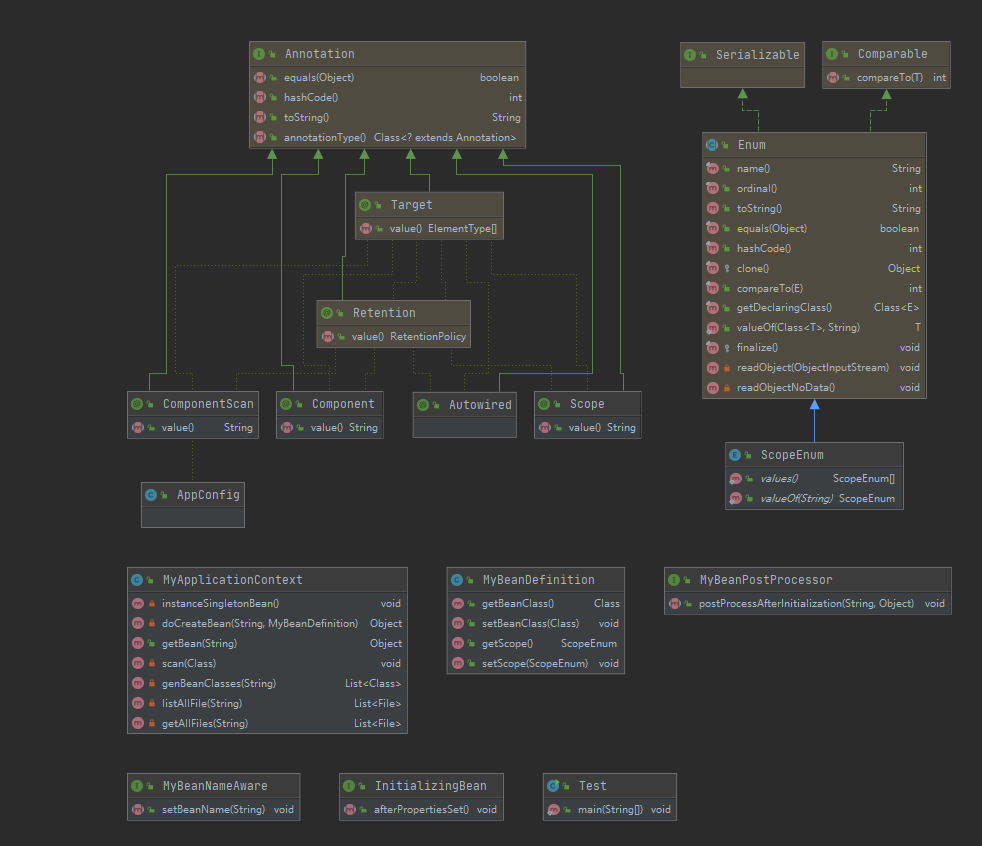Spring 学习笔记(一)手写一个简单的 Spring
发布于: 2020 年 10 月 11 日
概述
本文通过手写一个简单版的Spring,来帮助大家理解如下内容:
了解Spring工作的大概流程
熟悉BeanDefinition,BeanFactory,Bean等基本概念
熟悉Bean的生命周期,Bean的后置处理器等基本概念
代码设计
功能描述
demo版spring,理解spring加载Bean的过程。
类图

关键代码解读
MyApplicationContext
package com.test.spring;import com.google.common.collect.Lists;import com.google.common.collect.Maps;import java.io.File;import java.lang.reflect.Constructor;import java.lang.reflect.Field;import java.lang.reflect.InvocationTargetException;import java.net.URL;import java.util.ArrayList;import java.util.List;import java.util.Map;/** * 容器上下文类 */public class MyApplicationContext { private Map<String,MyBeanDefinition> beanDefinitionMap = Maps.newHashMap(); /**存放单例bean信息**/ private Map<String,Object> singletonObjects = Maps.newHashMap(); /**存放bean的后置处理器信息**/ private List<MyBeanPostProcessor> beanPostProcessorList = Lists.newArrayList(); /** * 通过构造方法加载非加载的单例bean * @param configClass 配置类 */ public MyApplicationContext(Class configClass) { //扫描配置类,并实例化beanDefinition scan(configClass); //实例化非懒加载的单例Bean instanceSingletonBean(); } /** * 实例化非懒加载的单例Bean */ private void instanceSingletonBean() { for (String beanName : beanDefinitionMap.keySet()) { MyBeanDefinition beanDefinition = beanDefinitionMap.get(beanName); if (beanDefinition.getScope().equals(ScopeEnum.singleton)) { Object bean = doCreateBean(beanName, beanDefinition); singletonObjects.put(beanName, bean); } } } /** * 创建bean * @param beanName * @param beanDefinition * @return */ private Object doCreateBean(String beanName, MyBeanDefinition beanDefinition) { Class beanClass = beanDefinition.getBeanClass(); try { // 实例化 Constructor declaredConstructor = beanClass.getDeclaredConstructor(); Object instance = declaredConstructor.newInstance(); // 填充属性 Field[] fields = beanClass.getDeclaredFields(); for (Field field : fields) { if (field.isAnnotationPresent(Autowired.class)) { String fieldName = field.getName(); Object bean = getBean(fieldName); field.setAccessible(true); field.set(instance, bean); } } // Aware回调 if (instance instanceof MyBeanNameAware) { ((MyBeanNameAware)instance).setBeanName(beanName); } // 初始化 if (instance instanceof InitializingBean) { ((InitializingBean)instance).afterPropertiesSet(); } for (MyBeanPostProcessor beanPostProcessor: beanPostProcessorList) { beanPostProcessor.postProcessAfterInitialization(beanName, instance); } return instance; } catch (NoSuchMethodException e) { e.printStackTrace(); } catch (IllegalAccessException e) { e.printStackTrace(); } catch (InstantiationException e) { e.printStackTrace(); } catch (InvocationTargetException e) { e.printStackTrace(); } return null; } public Object getBean(String beanName) { if (singletonObjects.containsKey(beanName)) { return singletonObjects.get(beanName); } else { MyBeanDefinition beanDefinition = beanDefinitionMap.get(beanName); return doCreateBean(beanName, beanDefinition); } } /** * 扫描配置类,并实例化beanDefinition * @param configClass 配置类 */ private void scan(Class configClass) { //获取配置类上的指定注解 ComponentScan componentScanAnnotation = (ComponentScan) configClass.getAnnotation(ComponentScan.class); //扫描的包 String basePath = componentScanAnnotation.value(); // 扫描包路径得到classList List<Class> classList = genBeanClasses(basePath); // 遍历class得到BeanDefinition for (Class clazz : classList) { if (clazz.isAnnotationPresent(Component.class)) { MyBeanDefinition beanDefinition = new MyBeanDefinition(); beanDefinition.setBeanClass(clazz); // 要么Spring自动生成,要么从Component注解上获取 Component component = (Component) clazz.getAnnotation(Component.class); String beanName = component.value(); if (MyBeanPostProcessor.class.isAssignableFrom(clazz)) { try { MyBeanPostProcessor instance = (MyBeanPostProcessor) clazz.getDeclaredConstructor().newInstance(); beanPostProcessorList.add(instance); } catch (InstantiationException e) { e.printStackTrace(); } catch (IllegalAccessException e) { e.printStackTrace(); } catch (InvocationTargetException e) { e.printStackTrace(); } catch (NoSuchMethodException e) { e.printStackTrace(); } } // 解析scope if (clazz.isAnnotationPresent(Scope.class)) { Scope scope = (Scope) clazz.getAnnotation(Scope.class); String scopeValue = scope.value(); if (ScopeEnum.singleton.name().equals(scopeValue)) { beanDefinition.setScope(ScopeEnum.singleton); } else { beanDefinition.setScope(ScopeEnum.prototype); } } else { beanDefinition.setScope(ScopeEnum.singleton); } beanDefinitionMap.put(beanName, beanDefinition); } } } /** * 获取指定路径下的所有类信息 * @param basePath * @return */ private List<Class> genBeanClasses(String basePath) { ArrayList<Class> classList = Lists.newArrayList(); ClassLoader classLoader = MyApplicationContext.class.getClassLoader(); List<File> fileList = listAllFile(basePath); fileList.forEach(s->{ String fileName = s.getAbsolutePath(); if( fileName.endsWith(".class")){ String className = fileName.substring(fileName.indexOf("com"), fileName.indexOf(".class")); className = className.replace("\\", "."); // System.out.println(className); try { Class<?> clazz = classLoader.loadClass(className); classList.add(clazz); } catch (ClassNotFoundException e) { e.printStackTrace(); } } }); return classList; } /** * 递归遍历,获取所有class文件 * @param basePath * @return */ private List<File> listAllFile(String basePath) { List<File> list = Lists.newArrayList(); ClassLoader classLoader = MyApplicationContext.class.getClassLoader(); basePath = basePath.replace(".", "/"); URL resource = classLoader.getResource(basePath); return getAllFiles(resource.getFile()); } private List<File> getAllFiles(String path){ List<File> list = Lists.newArrayList(); File file = new File(path); if (file.exists()) { File[] files = file.listFiles(); if (null != files) { for (File file2 : files) { if (file2.isDirectory()) { System.out.println("文件夹:" + file2.getAbsolutePath()); getAllFiles(file2.getAbsolutePath()); } else { list.add(file2); System.out.println("文件:" + file2.getAbsolutePath()); } } } } return list; }}MyBeanDefinition
package com.test.spring;/** * beanDefinition实体类 */public class MyBeanDefinition { /**bean对应的class对象**/ private Class beanClass; /**bean的生命周期枚举类**/ private ScopeEnum scope; public Class getBeanClass() { return beanClass; } public void setBeanClass(Class beanClass) { this.beanClass = beanClass; } public ScopeEnum getScope() { return scope; } public void setScope(ScopeEnum scope) { this.scope = scope; }}测试
package com.test;import com.test.spring.MyApplicationContext;public class Test { public static void main(String[] args) { MyApplicationContext myApplicationContext = new MyApplicationContext(AppConfig.class); System.out.println(myApplicationContext.getBean("userService")); }}输出了需要加载的Bean信息,OK大功告成!

源码地址
https://github.com/jijingunique/spring-learn.git
划线
评论
复制
发布于: 2020 年 10 月 11 日 阅读数: 16
版权声明: 本文为 InfoQ 作者【无语】的原创文章。
原文链接:【http://xie.infoq.cn/article/38fa519ae346081c121df4768】。文章转载请联系作者。
无语
关注
还未添加个人签名 2018.08.11 加入
还未添加个人简介









评论